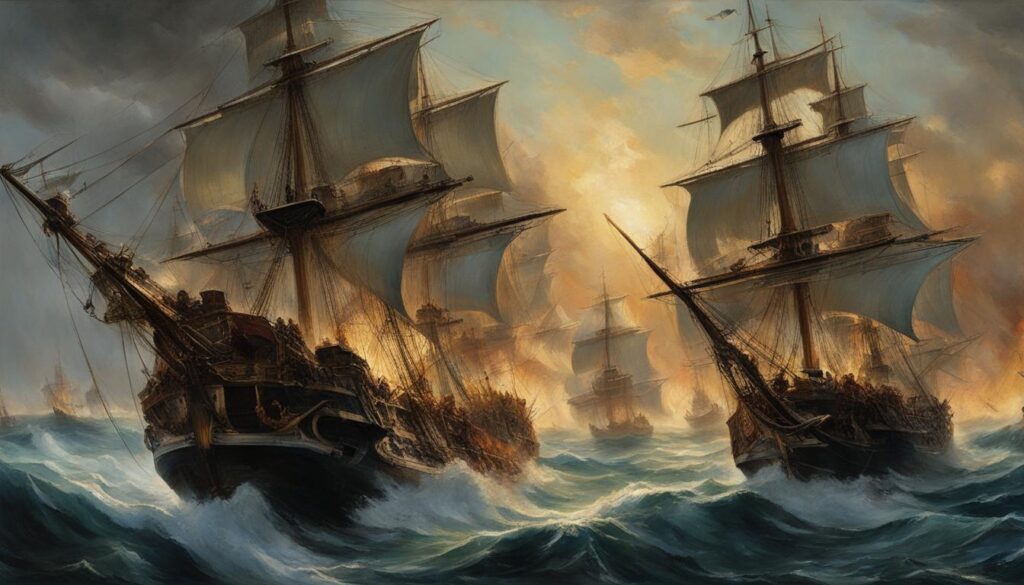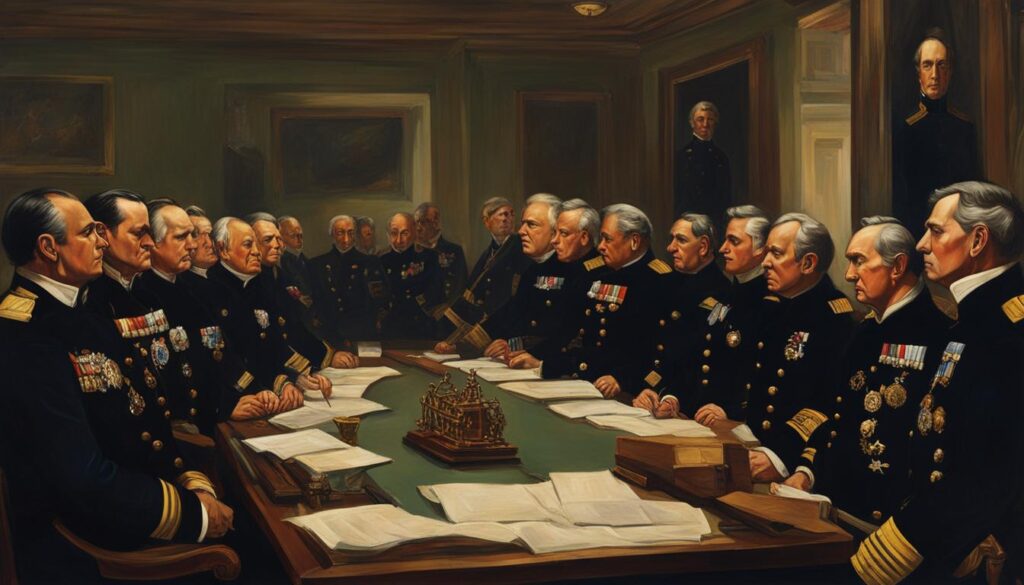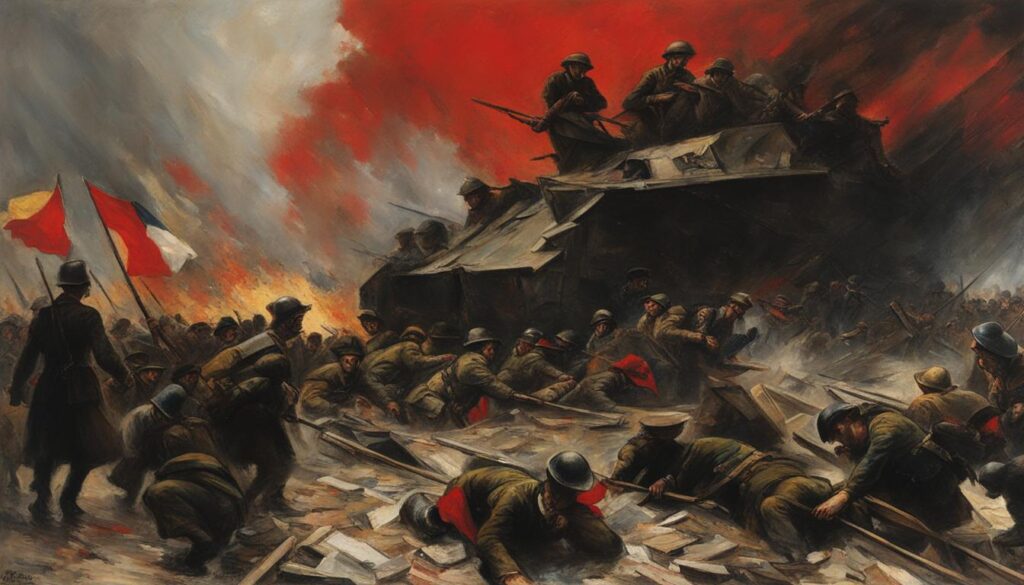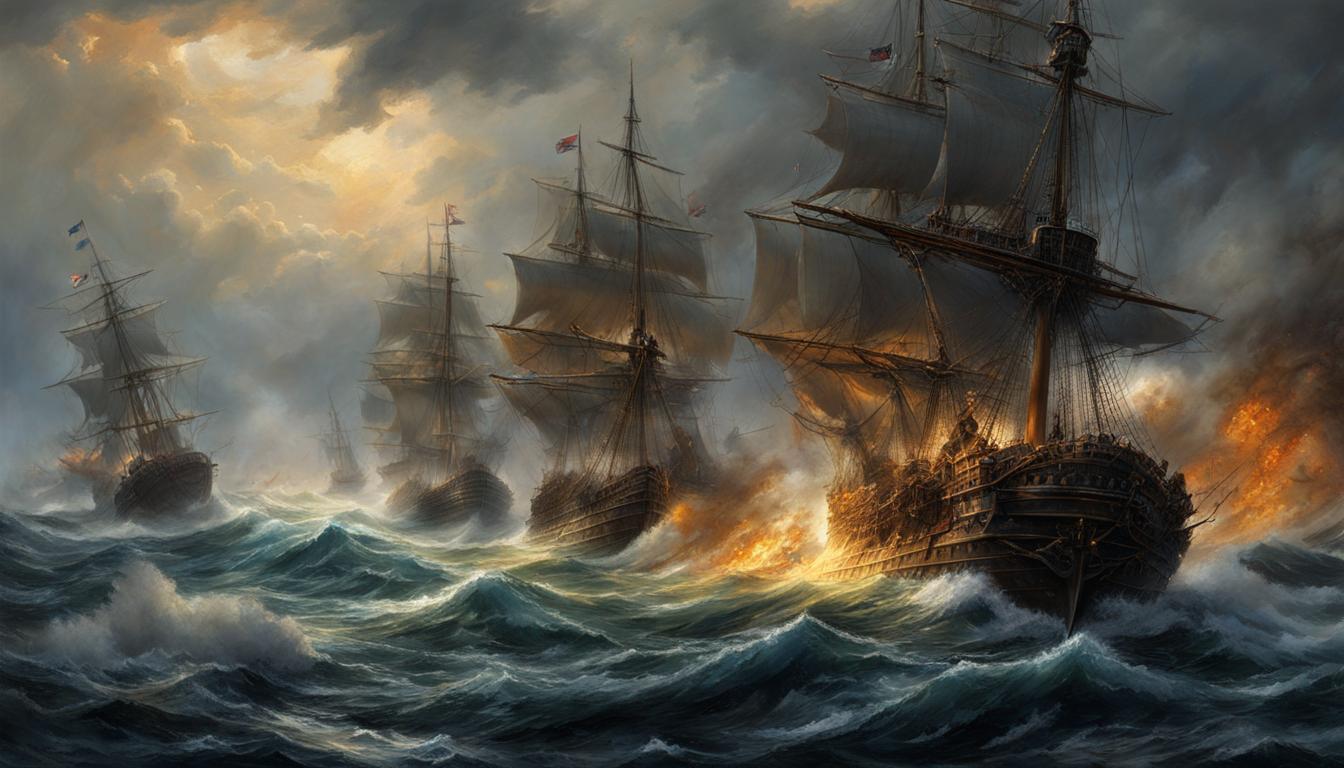The First Battle of Ushant stands as a pivotal moment in naval warfare and the broader historical contexts of both the American Revolutionary War and the Anglo-French War. Occurring off the coast of the strategically significant island of Ushant on July 27, 1778, this naval engagement marked the first major clash between British and French forces following France’s formal alliance with the American colonial forces. Despite concluding without a decisive victor, the battle’s outcome ignited political turmoil, setting the stage for subsequent events in the 1778 naval engagements.
Key Takeaways
- The First Battle of Ushant was a significant event during the American Revolutionary War and the Anglo-French War.
- Ushant, an island near the entrance of the English Channel, held strategic importance for both British and French forces.
- The battle involved British Admiral Augustus Keppel and French Vice-Admiral Comte d’Orvilliers, among other key figures.
- Although the skirmish ended inconclusively, it had far-reaching political and military consequences for both nations involved.
- The First Battle of Ushant signaled the beginning of more substantial French involvement in the American colonies’ fight for independence.
Overview of the First Battle of Ushant Revolutionary War History
The First Battle of Ushant was a significant event in the Revolutionary War history, as it marked the initial confrontation between British and French naval forces. This major sea battle took place on July 27, 1778, about 100 miles west of the French island of Ushant. It was here that the two warring nations first went head-to-head after France’s formal alliance with the American colonies. Although the encounter concluded without a definitive victor, it highlighted the growing strategic importance of naval supremacy in the American Revolutionary War.
Throughout the entire engagement, a total of 73 ships-of-the-line were deployed. The British fleet, commanded by Admiral Augustus Keppel, consisted of 30 ships-of-the-line. On the other hand, the French fleet, under the leadership of Vice-Admiral Comte d’Orvilliers, had a slight advantage with 32 ships-of-the-line at their disposal. Despite this numerical superiority, the French were unable to capitalize on their advantage, and the battle ended in a tactical stalemate.
“It was the first major naval battle between Britain and France after the latter’s formal alliance with the American colonies.”
Here are the major events of the First Battle of Ushant Revolutionary War:
- Both fleets sighted each other on July 23, 1778, but due to unfavorable wind conditions, they only engaged in combat four days later.
- On July 27, the two opposing fleets began a series of pass-through engagements as they tried to establish a battleline.
- The British fleet attempted to cut through the French line. However, unforeseen changes in wind direction thwarted their plans and forced them to adapt their strategies mid-battle.
- After a day of fighting, both fleets disengaged and withdrew from the battle zone, without inflicting or suffering decisive losses.
- The aftermath of the inconclusive battle led to political turmoil in Britain and controversy in France, as key figures on both sides faced trials and scrutiny for their actions during the engagement.
In the context of the Revolutionary War history, the First Battle of Ushant proved to be a critical point at which foreign intervention in the conflict was solidified. While the battle itself did not produce a clear victory for either side, it showcased the growing tensions between the European powers and their impact on the ongoing fight for American independence.
Navigating the Waters: Battle Location and Strategic Importance
The First Battle of Ushant took place in the Bay of Biscay within the vast Atlantic Ocean. The specific coordinates of this pivotal battle were 48°33′37″N 7°22′58″W. This encounter between the powerful British and French naval forces highlighted the immense strategic significance of the Ushant Island, given its proximity to the English Channel.

Ushant Island held an important strategic naval position as it served as a potential gateway to the English Channel, which was crucial for both nations in asserting their naval prowess. This naturally made it a primary battleground for these adversaries seeking to display their naval strength and gain control of critical maritime routes.
Control of Ushant Island was vital for naval powers, as it allowed the nation in command to demonstrate its supremacy and command the strategic passage to the English Channel.
The fierce contest over Ushant demonstrates the unique importance of the First Battle of Ushant in the broader context of the American Revolutionary War. It not only sparked political turmoil and widened political divisions, but it also marked the beginning of intensified naval warfare between Britain and France.
Ultimately, the First Battle of Ushant battle location served as a testimony to the strategic value of gaining maritime dominance in the English Channel. Both Britain and France understood the importance of controlling this strategic waterway, and the Ushant Island was crucial to achieving this goal.
- Coordination in battle zone: 48°33′37″N 7°22′58″W
- Strategic Significance: Proximity to the English Channel
- Naval Powers Involved: Great Britain and France
Clashing Titans: Key Figures of the Encounter

The First Battle of Ushant saw a formidable assembly of British and French leaders, whose actions, strategies, and personal rivalries greatly influenced the course and outcome of the engagement. This section delves into the key figures from both sides, focusing on British naval officers, Admiral Augustus Keppel and Sir Hugh Palliser, and their French counterpart, Comte d’Orvilliers.
Admiral Augustus Keppel and Rival Hugh Palliser
Two important British figures in the First Battle of Ushant were Admiral Augustus Keppel and Sir Hugh Palliser. Keppel held the prominent role of British fleet commander, persistently pursuing French ships during the battle from his flagship, the HMS Victory. His relationship with Palliser, who commanded the fleet’s rear division, would prove vital to the battle’s unfolding and eventual consequences.
Palliser’s perceived reluctance to support his superior, Keppel, during the engagement led to rising tensions between the two men. In the heat of battle, Keppel had signaled Palliser to engage the enemy, but Palliser’s ships appeared slow to respond. This delay added fuel to existing disagreements between the two men, directly impacting the British operational effectiveness and the battle’s outcome.
Comte d’Orvilliers: The French Perspective
Vice-Admiral Comte d’Orvilliers led the French fleet during the encounter off Ushant. His forces outnumbered the British, boasting thirty-two ships-of-the-line and a number of smaller vessels. Despite this numerical advantage, d’Orvilliers had orders to exercise caution, avoiding major engagements unless absolutely necessary.
As the British and French fleets closed in on each other, d’Orvilliers focused on maintaining a defensive posture, seeking to prevent a decisive British victory. Ultimately, neither side would emerge the unquestioned victor, as the engagement concluded without a clear-cut outcome. The actions and decisions of these three key figures – Keppel, Palliser, and d’Orvilliers – contributed to the inconclusive end of the First Battle of Ushant.
An Indecisive Outcome: Analyzing the Battle’s Tactics
The First Battle of Ushant was characterized by its indecisive outcome, with neither the British nor the French fleets achieving a clear victory. Several factors contributed to the inconclusive nature of the encounter, with changing weather conditions and adjustments in naval tactics playing a crucial role.
A change in wind direction during the battle forced both fleets to alter their strategies on the fly. The British, commanded by Admiral Augustus Keppel, had initially planned to save their salvo for the French flagship. In contrast, the French ships had focused their efforts on targeting the British rigging. However, as the wind shifted, both sides had to adapt their plans and rethink their tactics.
“A change in wind direction during the battle forced both fleets to alter their strategies on the fly.”
One aspect of the naval engagement worthy of analysis is the tactical decision-making displayed by both fleets. A closer look at their actions reveals the following key tactics employed during the battle:
- The British focused on saving their salvo to target the French flagship.
- The French concentrated their efforts on British rigging, intending to incapacitate several ships.
- Both fleets had to quickly adjust to the change in wind direction and adapt their initial plans accordingly.
Despite these tactical adjustments, neither fleet was able to deliver a decisive blow to the other, with both sides suffering relatively minor damage and casualties. The battle ended inconclusively, with both fleets disengaging and retreating to their respective bases.
| British Fleet | French Fleet |
|---|---|
| Commanded by Admiral Augustus Keppel | Commanded by Vice-Admiral Comte d’Orvilliers |
| Targeted French flagship | Targeted British rigging |
| Adjusted tactics due to change in wind direction | Adjusted tactics due to change in wind direction |
| Inconclusive outcome | Inconclusive outcome |
The indecisive outcome of the First Battle of Ushant highlights the complexities of 18th-century naval warfare, showcasing the unpredictable nature of sea battles and the need for flexible tactical decision-making by both fleets. The engagement remains an essential case study for naval historians while continuing to evoke debates and discussions on the strategic choices and repercussions of this pivotal naval confrontation.
The Political Storm: Aftermath and Repercussions in Britain

Following the First Battle of Ushant, the indecisive outcome led to a political storm in Britain, with the two key figures of the conflict, Admiral Keppel and Sir Hugh Palliser, facing severe consequences for their actions.
Admiral Keppel’s Court-Martial and Resignation
Upon returning to Britain after the battle, Admiral Keppel, who commanded the British fleets, was subjected to a court-martial. Despite the intense scrutiny on his decisions during the battle, the court ultimately acquitted Keppel of all charges. Nevertheless, the controversy and personal rifts created during the trials led to his voluntary resignation from the navy.
Although acquitted, the personal and political effects of the court-martial forced Admiral Keppel to resign from the navy, sending ripples throughout the British naval establishment.
Sir Hugh Palliser’s Role and Ensuing Controversy
Similar to Admiral Keppel, Sir Hugh Palliser faced considerable controversy due to his actions during the battle. As the commander of the rear division of the British fleet, he was criticized for his failure to engage effectively and support the rest of the fleet. As a result, the scrutiny on Palliser’s performance added fuel to the growing political factionalism within the British government.
Moreover, Palliser’s actions and perceived negligence during the battle led to an inquiry, eventually culminating in a court-martial. Despite the extensive analysis of his decisions during the conflict, the court acquitted Palliser as well.
- Keppel’s court-martial and resignation
- Palliser’s involvement in the battle and controversy
- Acquittal of both commanders after the court-martial
| Admiral | Court-Martial | Outcome |
|---|---|---|
| Admiral Keppel | Conduct during the battle | Acquittal and resignation |
| Sir Hugh Palliser | Failure to engage effectively | Acquittal |
In conclusion, the First Battle of Ushant not only impacted the military landscape but also ignited a political storm within Britain. The repercussions of the indecisive outcome led to the court-martial of both Admiral Keppel and Sir Hugh Palliser and the eventual resignation of Admiral Keppel. These events highlighted the high stakes of naval command during the American Revolutionary War and the significant consequences of perceived failures.
The Waves of Reaction in France After the Battle
Despite the indecisive nature of the First Battle of Ushant, the French naval action repercussions were keenly felt. Celebrations erupted when the Duke of Chartres, upon his return to France, initially proclaimed victory. However, controversy surrounding the battle’s outcome soon emerged. The Comte d’Orvilliers controversy arose as further analysis of the encounter came to light, showing that the battle was not as decisive as initially claimed.
Skepticism persisted among the French public and navy officers over the true impact of the Battle of Ushant and the roles played by key figures in the engagement. Chartres’ return to Brest was met with mixed reactions and marred by an atmosphere of disarray, rumors, and disagreements among French naval officers. Disputes among them began to brew, putting the spotlight on the effectiveness of their command structure and raising questions about France’s preparation for future naval engagements.
“The Battle of Ushant was seemingly a victory, but on closer inspection, success was far more elusive.”
As the reality of the battle’s true outcome set in, the French public held their navy commanders accountable for their perceived failings. The Comte d’Orvilliers and the Duke of Chartres were thrust into the center of the controversy, with accusations and scrutiny hounding their every move. The French navy, once buoyed by the prospect of victory, began to face internal divisions and strained relationships among its ranks.

- Initial celebrations of perceived French victory
- Subsequent emergence of controversy and doubts
- Disputes among French naval officers
- Scrutiny of Comte d’Orvilliers and the Duke of Chartres
- Internal divisions within the French navy
In conclusion, the First Battle of Ushant was a pivotal moment in Franco-British naval history and the wider American Revolutionary War. The repercussions of this undecisive encounter were felt not only in Britain but also in France, where controversies raged around the outcome and key figures like the Comte d’Orvilliers. These events left an indelible mark on the French navy and public, serving as a cautionary tale for the future conduct of naval warfare.
Advancing Naval Warfare: Technological and Tactical Innovations
The First Battle of Ushant highlighted the evolution of naval tactics and technological innovations in 18th-century naval warfare. One remarkable tactical approach adopted by the French during the battle was targeting British riggings, which effectively incapacitated several enemy ships. This novel approach paved the way for further advancements in naval tactics.
Subsequent engagements also witnessed the deployment of new weaponry, significantly impacting the course of naval warfare. For instance, the introduction of the carronade in the late 18th century heralded the era of shorter-range, high-power artillery in naval combats. This powerful weapon packed a punch, increasing a ship’s firepower while remaining relatively lightweight.
“Innovation in naval warfare is a constant and indispensable factor. The introduction and utilization of new weaponry, strategies, and technologies contribute to a sea power’s ability to maintain a competitive edge.”
Here is an overview of some key technological advancements and their impact on naval tactics and warfare during the 18th century:
| Technological Advancement | Impact on Naval Tactics | Examples |
|---|---|---|
| Improved ship design | Better maneuverability and speed, enhancing naval fleet performance | Clipper ships, frigates |
| Carronade | Increased short-range firepower, devastating enemy ships at close quarters | British Royal Navy’s extensive use of carronades |
| Signal flags | Enhanced communication between vessels, leading to coordinated fleet maneuvers | British Admiral Lord Howe’s signal book |
| Targeting riggings | Ability to cripple an enemy ship’s capacity to sail and maneuver, exposing it to further attacks | French fleet tactics during the First Battle of Ushant |
These advancements in naval technology and the evolution of tactics played a crucial role in shaping the outcome of 18th-century naval engagements, such as the First Battle of Ushant, demonstrating the importance of constant innovation in maintaining a competitive edge in naval warfare.
Assessing the Impact: Significance of the Battle in American Revolution
The First Battle of Ushant had broader implications for the American Revolution. France’s show of naval strength supported their American allies, despite the indecisive battle outcome. It marked a pivotal moment when foreign intervention became more tangible in the struggle for American independence.
Although the First Battle of Ushant did not result in a clear victor, it did showcase the French Navy’s commitment to supporting the American colonies. The strategic alliance between France and the United States played a crucial role in undermining British dominance and contributed to the eventual success of the revolutionary cause.
It marked a pivotal moment when foreign intervention became more tangible in the struggle for American independence.
Key American political figures, like Benjamin Franklin and John Adams, actively sought French support during the war. The First Battle of Ushant signaled to the American colonies that they were not alone in their fight against the British Empire. This assurance bolstered their morale and strengthened their resolve to gain independence.
Furthermore, the French intervention illustrated just how critical colonial success in the American Revolution was for France. As a long-standing enemy of Britain, a weakened British Empire afforded France an opportunity to extend its influence in the New World. French involvement in the war suggests that America’s fight for independence was connected to larger geopolitical struggles.
France’s show of naval strength supported their American allies, despite the indecisive battle outcome.
- First point of impact: Bolstered morale among American revolutionaries with the prospect of foreign support in their fight for independence.
- Second point of impact: French intervention demonstrated the larger geopolitical implications of the American Revolutionary War, as it offered the French an opportunity to undermine the British Empire and expand their influence.
In conclusion, while the First Battle of Ushant did not deliver a significant tactical victory to either the British or the French, its impact on the American Revolution cannot be understated. The battle signified a shift in the international landscape, as foreign forces, particularly the French, recognized the importance of aiding the American colonies in their pursuit of independence. Consequently, the battle secured both short-term and long-term effects on the American Revolution, proving its significance as a crucial turning point in the fight for freedom.
The Tides of War: Long-term Consequences on American Independence
The First Battle of Ushant carries substantial significance in the context of the American War for Independence. Though the battle did not end in a decisive victory, it did demonstrate the strategic and military alliance between France and the American colonies, providing critical support for the colonists in their quest for independence. This cooperative effort contributed to the broader international aspect of the conflict, ultimately playing a crucial role in the success of the American Revolution.
The long-term effects of the Ushant battle extend to several key areas of the American Revolutionary War. Some of these include:
- French naval power challenging British dominance in the Atlantic;
- Increased foreign support for the American struggle for independence;
- Encouragement of other nations to join the conflict, such as Spain and the Dutch Republic;
- Strengthening the global perception of the viability of an independent United States.
One of the most notable consequences of the Ushant battle was the increased foreign support the American colonies received. The French alliance with the colonies not only provided significant naval assistance, but it also proved to the world the viability of their cause. This would later encourage other nations, including the Spanish and the Dutch Republic, to join in the fight against the British Empire.
In particular, the battle showcased the French navy’s willingness to engage with Britain’s powerful naval force, thereby posing a considerable challenge to British naval dominance in the Atlantic. France’s determination to maintain a significant presence in the theater of war played an essential role in securing the eventual American triumph.
“The French alliance […] provided significant naval assistance, […] [proving] to the world the viability of their cause.”
Ultimately, the long-term effects of the Ushant battle contributed to the larger international dimension of the American struggle for independence. The willingness and capability of France and other European powers to support and ally with the American colonies proved to be a critical factor in the eventual victory over the British Empire—and the establishment of an independent United States of America.
Conclusion
The historical significance of the First Battle of Ushant cannot be overstated as an important chapter in both naval and Revolutionary War history. Though the naval battle itself yielded indecisive outcomes, it illuminated the strategic alliance between France and the American colonies and demonstrated the tangible role foreign intervention played in the struggle for American independence.
Not only did the First Battle of Ushant affect the conduct of the war, but it also had a profound impact on the careers and lives of key figures involved, such as Admiral Augustus Keppel and Comte d’Orvilliers. The resulting political turmoil and factionalism in Britain served as a harbinger of the greater struggles that would follow. The battle would become a crucial moment in the unraveling of the British Empire’s dominance over the American colonies.
As we reflect on the Ushant battle legacy, the engagement continues to be studied for its complex strategic elements and its role in shaping international warfare dynamics. The First Battle of Ushant serves as a sobering reminder of the unpredictable nature of warfare and the ever-evolving tactics and technologies employed to achieve victory.
FAQ
When and where did the First Battle of Ushant take place?
The First Battle of Ushant occurred on 27 July 1778, off the island of Ushant at the entrance of the English Channel. It took place approximately 100 miles west of the island in the Bay of Biscay, Atlantic Ocean.
Who were the key figures involved in the First Battle of Ushant?
The key figures in the battle included Admiral Augustus Keppel, commanding the British fleet from the HMS Victory, and his subordinate Sir Hugh Palliser. On the French side, the fleet was led by Vice-Admiral Comte d’Orvilliers.
What was the outcome of the First Battle of Ushant?
The First Battle of Ushant concluded without a decisive winner, as a change in wind direction forced both fleets to adjust their tactics. The indecisive outcome led to political turmoil in Britain and France, with both naval commanders facing significant repercussions.
How did the First Battle of Ushant impact the American Revolutionary War?
The First Battle of Ushant marked the first major naval engagement between Britain and France following the latter’s formal alliance with the American colonies. Though the battle was inconclusive, it showcased the strategic and military alliance between France and the American colonies, adding an international dimension to the conflict, which was instrumental in achieving American independence.
What were the tactical innovations seen in the First Battle of Ushant?
One notable tactical innovation during the battle was the French targeting of British riggings, which incapacitated several ships and demonstrated an evolution in naval warfare. Further advancements, such as the deployment of new weaponry like the carronade, were seen in subsequent engagements.

